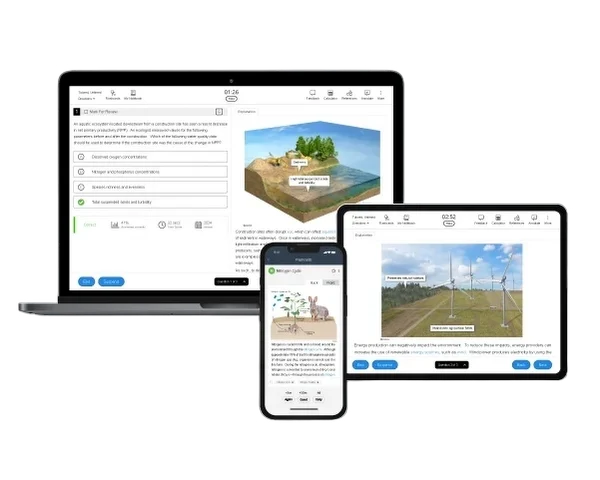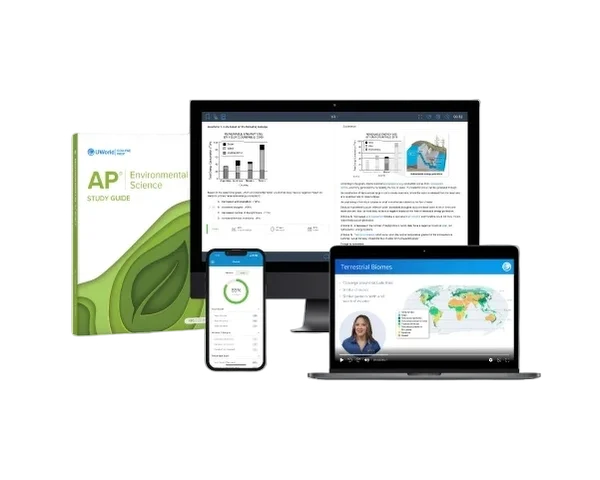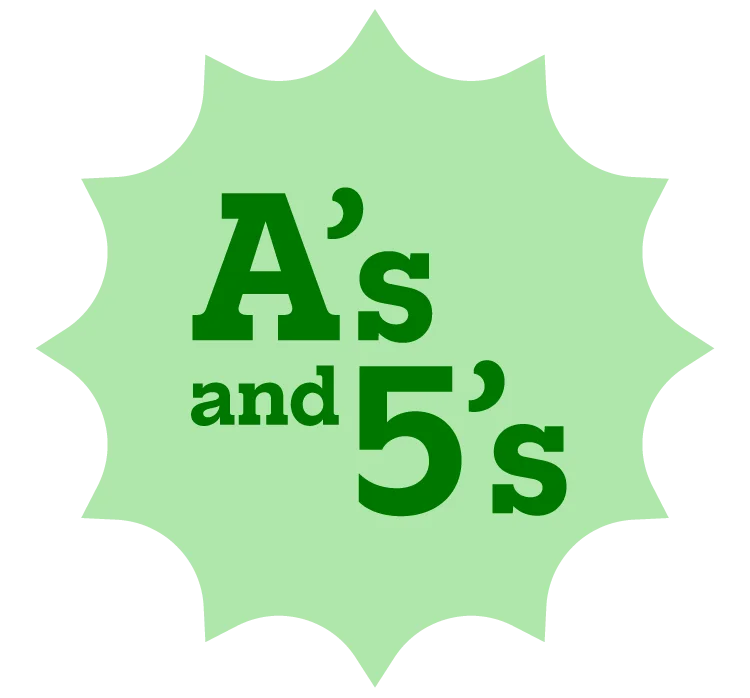The first section of the AP® Environmental Science exam lasts 1 hour and 30 minutes and consists of 80 multiple-choice questions. These questions may appear either as standalone items or in sets. Section 1 counts for 60% of your final exam score. You can pass this section if you know how to approach the different kinds of MCQs on the exam.
The following is a list of all the AP Environmental Science MCQ types you will encounter on Section 1 of the exam:
- Simple text-based questions
- Complex text-based questions
- Visual representation-based questions
- Data table and graph-based questions
- Mathematical routine-based questions
- Article-based questions
The type of question often aligns with a specific science practice outlined in the AP Environmental Science course and description (CED). For example, article-based questions generally require you to apply Science Practice 3, although some may involve Science Practice 4 or 7.
For comprehensive preparation, explore our AP Environmental Science Study Guide in digital and print formats to help you master these question types.
How to Approach AP Environmental Science Multiple-Choice Questions
Each question type you encounter will be unique and should be approached differently to get the right answer. We have listed the different types of questions you might see on the AP Environmental Science exam and provided tips to help you confidently tackle and select the correct answer.
AP Environmental Science Multiple-Choice Examples
Simple-Form Text-Based
For this type of MCQ, the answer choices will describe or explain concepts or processes that are provided in the question. These simple-form text questions generally test your knowledge-based skills. However, you should not assume that simple-form questions are easy; you could be tested on a fairly difficult concept with a question from this category. Practicing AP Environmental Science multiple-choice questions can help you get familiar with different question types and difficulty levels.
Below is a UWorld example of this question type:
Example 1
Which of the following is the most likely biotic route for atmospheric nitrogen to enter the food web?
- cyanobacteria → stream → soil → groundwater → human
- bacteria → roots → leaves → rabbit
- lightning → precipitation → soil → plant → deer
- fertilizers → soil → roots → bacteria
Complex-Form Text-Based Questions
Complex-form questions generally give some background information that you will have to combine with your existing knowledge to pick the right answer. Similarly, you should not assume that long-form text questions are more difficult. Sometimes an exam question can overwhelm you with its lengthy text, but it asks for a very simple concept. These complex-form questions are often used to ask scientific experiment questions, such as how to write a hypothesis, identify the experimental parameters (independent variable, dependent variable, control group), and improve the accuracy of experimental results (larger sample size, repeat experiment).
Below is a UWorld example of this question type:
Example 2
A student interested in studying the nitrogen cycle wants to carry out an experiment to determine how denitrification is affected by different types of soil bacteria. The student places moist, nutrient-rich soil at the bottom of airtight containers, adds different types of soil bacteria to each container, and incubates the containers at room temperature for three days. After the experiment, the student measures the levels of nitrogen compounds in the soil and air in each container. Which of the following best identifies a variable of the experimental design?
- The independent variable is the concentration of nitrate in the soil.
- The dependent variable is the concentration of nitrogen gas in the containers.
- The control is incubation time and temperature.
- The constant is the rate of nitrogen fixation.
Visual Representation-Based Questions
This type of question provides a diagram in the question stem with text above and/or below the diagram. These questions can include specialized diagrams, such as a soil texture triangle, or more general diagrams, such as food webs or maps. Either way, you must analyze the diagram to select the correct answer to the question. Below is a UWorld example of this question type:
Example 3
The diagram below shows the interaction between a giraffe and a gazelle in the African savanna.

Which of the following statements correctly explains the interaction between the giraffe and the gazelle?
- The giraffe and the gazelle are in a mutualistic relationship with the tree.
- Intraspecific competition occurs between the giraffe and the gazelle.
- The giraffe and the gazelle engage in resource partitioning.
- The tree, the giraffe, and the gazelle have a parasitic relationship.
Data Table and Graph-Based Questions
Questions of this type involve the presentation of data in either a table or a graph. The question stem often includes some additional text associated with the data. You will need to use the given data, along with any other information given in the question text, to select the right answer. Sometimes, you may also need to recall content knowledge to answer this type of question. Below is a UWorld example of this question type:
Example 4
POPULATION SIZE OF WOLVES AND MOOSE IN AN ECOSYSTEM
| Year | Wolf Population | Moose Population |
|---|---|---|
| 1980 | 50 | 664 |
| 1985 | 22 | 1,062 |
| 1990 | 15 | 1,216 |
| 1995 | 16 | 2,400 |
| 2000 | 29 | 850 |
| 2005 | 30 | 540 |
| 2010 | 19 | 510 |
| 2015 | 3 | 1,250 |
Based on the table, which of the following claims about the relationship between the wolves and the moose is supported?
- The wolves and moose have a symbiotic relationship; the wolves eat the predators of the moose, causing the moose population to increase.
- The wolves and moose have a predator-prey relationship; the wolves prey on the moose for food, causing the moose population to decrease.
- The wolves and moose have a competitive relationship; the wolves and moose partition resources, such as water, for survival, causing both populations to increase over time.
- The wolves and moose have a commensal relationship; the moose maintain the wolves' habitat, and neither population is affected.
Mathematical Routine-Based Questions
This type of question involves taking the information provided in the question stem and performing a calculation to get the right answer or finding the mathematical method required to answer the question. Sometimes, the information you need to do the calculation is in the text. Other times, it will be found in a table or graph. Below is an example of this question type:
Example 5
Scientists monitored the net primary productivity and respiration rate of a savanna ecosystem to determine how much life can be supported within the ecosystem. The net primary productivity of the savanna was about 1,980 kcal/m2/year, and the respiration rate was measured as about 1,020 kcal/m2/year. Which of the following methods should be used to determine the gross primary productivity of the ecosystem?
- 1,980 kcal/m2/year−1,020 kcal/m2/year
- 1,020 kcal/m2/year+1,980 kcal/m2/year
- (1,980 kcal/m2/year)/(1,020 kcal/m2/year)
- (1,020 kcal/m2/year)/(1,980 kcal/m2/year)
Article-Based Questions
This type of question involves reading a lengthy news article to determine the author's claim, intent, and perspective on the subject of the article. Additional questions may require finding a piece of evidence used by the author to support a claim or identifying a solution to an environmental problem highlighted in the article.
Passage 1
An Ecological Overview of Denali National Park and Preserve
During the past two million years, Denali's history has been characterized by repeated advances and retreats of a massive ice sheet. Over half of the park (Alaska Range and south) was intermittently covered by an extension of the ice sheet in Canada.…
Glacial ice has retreated significantly since the Pleistocene. Today, only about 16% of the park is covered by ice or perennial snow fields. However, glaciers continue to have a cooling effect near their termini and downstream. Glacial meltwaters affect local weather conditions and reconfigure floodplains downstream.…
The local ecosystems are shaped by the physical environment (geology, glaciers, climate). Interactions among these factors and the habitat preferences of plants create the mosaic of vegetation on the landscape. For example, stunted scattered spruce in northern areas of the park grow over permafrost, while more lush vegetation is supported on permafrost-free areas.…
The major processes on the landscape vary across ecological zones. Geomorphic disturbances such as landslides, avalanches, and other mass movements predominate in the alpine region.…
The action of flowing water is another important natural disturbance process in boreal lowlands. Large braided glacial rivers such as the McKinley, Toklat, Yentna, and Chulitna are constantly reshaping the land by shifting channels, creating new floodplain deposits, and eroding old terraces with established forests….
Denali is located in the northern boreal forest biome. The landscape is predominantly forested at elevations less than 2,500 feet, with scrub vegetation and spruce woodland in the subalpine zone and low tundra in the alpine zone (above 3,500 feet).…
Despite being a wilderness park, Denali faces threats from human activity on many scales, including increased tourism and development, introduction of exotic species, increased hunting pressures, and accumulation of trace amounts of global airborne contaminants. The retreat of glaciers and changes in vegetation due to climate change are easily seen in photographs taken only decades apart. These influences and their effects are difficult to measure, but they may dramatically alter the distribution and visibility of wildlife. Park management faces an increasing challenge to protect resources in the face of climate change and other human effects.
Credit: National Park Service
Example 6
Which of the following best identifies the author's claim in the article?
- Glacier retreats have been offset by frequent glacier advancements.
- Anthropogenic activities have reshaped the land by shifting channels and reconfiguring floodplains.
- Natural resource distribution has varied due to changes in climate and altitude.
- The retreat in glacial ice has led to decreased productivity in Denali National Park.
For additional practice, explore our AP Environmental Science Online Course, which includes engaging videos, detailed answer explanations, and much more for better retention.

Tips To Answer AP Environmental Science Multiple-Choice Questions
Follow these strategies to excel in multiple-choice questions using Bluebook tools:
-
Read and Highlight Key Details
- Carefully read the question and use Bluebook's "Highlight and Notes" feature to mark important terms or instructions.
-
Analyze the Information Provided
- Passages: Skim for main ideas and focus on the parts referenced in the question.
- Graphs and Tables: Look for trends or significant data points. Use "Zoom" for clarity.
- Visuals: Study diagrams to identify labels and key elements.
-
Use Bluebook Tools
- Option Eliminator: Cross out wrong answers.
- Scratchpad: Solve calculations or jot observations.
- Mark for Review: Flag questions to revisit later.
-
Apply Smart Strategies
- For hypotheses, identify variables being tested.
- For controls, choose answers excluding the tested variable.
- For math problems, double-check calculations.
-
Eliminate and Guess if Needed
- Rule out incorrect options and choose the most logical answer. Mark unsure questions for review.
By combining these strategies with Bluebook tools, you can confidently tackle all question types. Although the test won't provide you with a formula sheet, refer to the AP Environmental Science formula sheet that we have compiled to know which equations and formulas you should memorize while preparing for the exam. On your exam date, bring an approved calculator with backup batteries.
How can I Practice AP Environmental Science Multiple-Choice Questions?
The UWorld question bank has hundreds of APES questions, so going through our question bank and carefully reading the answer explanations is the best way to practice for the AP Environmental Science exam's MCQ section. Our AP Environmental Science practice tests can help you prepare for this section with customized practice tests tailored to suit your needs and boost your chances of getting a high score.
Frequently Asked Questions (FAQs)
How are AP Environmental Science multiple-choice questions graded?
A computer will grade your answers.
How long is the multiple-choice question section of the AP Environmental Science Exam?
Section 1 is a combination of individual and set-based questions. You will have 1 hour and 30 minutes to answer the 80 MCQs.
How many multiple-choice questions do you have to get right on the AP Environmental Science exam?
The AP Environmental Science exam consists of 2 parts, the multiple-choice question (MCQ) and free-response question (FRQ) sections. The number of questions that you need to get right in the MCQ section depends on how you perform in the FRQ section.
Where can I find past AP Environmental Science multiple-choice questions?
Because of the redesign of the course, there are not too many places that have up-to-date examples of AP Environmental Science MCQs. However, the College Board® has released 15 questions on the recent AP Environmental Science course and exam description (CED).
References
- (2024). Exam Components. About the Exam. AP Environmental Science. College Board. Retrieved on December 18, 2024 from https://apstudents.collegeboard.org/courses/ap-environmental-science/assessment
- (2020). Science Practices. Course Framework. AP® Environmental Science Course and Exam Description. College Board. Retrieved on December 18, 2024 from https://apcentral.collegeboard.org/media/pdf/ap-environmental-science-course-and-exam-description.pdf

Read More About the AP Environmental Science Exam
Many students find it difficult to answer FRQs adequately. For a step-by-step guide on how to successfully respond to AP Environmental Science FRQs, click here.
AP Environmental Science Exam FormatAre you interested in learning the AP Environmental Science exam format? Here is some info on the test structure that you should be aware of before beginning your prep.
How to Study for AP Environmental ScienceWant a perfect score of 5 to get into a top university? Here's our expert guide on how to study for AP Environmental Science, with tips to simplify your prep.
Best AP Environmental Science Course ReviewLooking for the best AP ES course? Check out our expert reviews and comparisons to find the right prep for a top score.
AP Environmental Science Study Guide ComparisonNot sure which study guide to choose? We break down the best AP ES prep books to help you study smarter.
How to Self-Study for AP Environmental ScienceWant to ace AP ES on your own? Follow our step-by-step guide with expert tips and must-have resources.




